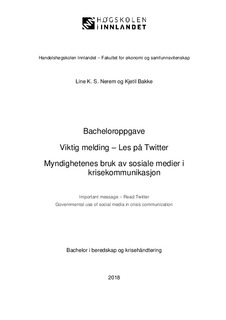| dc.contributor.author | Bakke, Kjetil | |
| dc.contributor.author | Skavern Nerem, Line Kristin | |
| dc.date.accessioned | 2019-01-14T10:26:24Z | |
| dc.date.available | 2019-01-14T10:26:24Z | |
| dc.date.issued | 2018 | |
| dc.identifier.uri | http://hdl.handle.net/11250/2580442 | |
| dc.description | Bacheloroppgave i beredskap og krisehåndtering | nb_NO |
| dc.description.abstract | Denne bacheloroppgaven er et resultat av Bachelorstudiet i beredskap og krisehåndtering ved Høgskolen i Innlandet, campus Rena. Sosiale medier har kommet for å bli, og det er blitt et stadig mer benyttet verktøy for informasjonsdeling, ikke bare blant befolkningen, men også som et verktøy for informasjonsdeling fra myndigheter til befolkning når det gjelder aktuelle hendelser. Aktuelle hendelser innebærer her alt fra ulykker og kriser til flomvarsler og varsler om strømbrudd. Sosiale medier er et relativt nytt verktøy, men vi oppfatter det slik at stadig flere kommuner og etater implementerer bruk av sosiale medier i f.eks. sin krisekommunikasjonsplan, om enn, ikke i full grad enda. Vi ønsker gjennom denne oppgaven å undersøke om det vil være hensiktsmessig for myndighetene å rette et sterkere fokus mot bruk av sosiale medier i sin krisehåndtering, for å kunne nå ut med hensiktsmessig informasjon til større deler av befolkningen på et tidligere tidspunkt i krisehåndteringen. Vi valgte følgende hovedproblemstilling: «Hvordan kan myndighetenes bruk av sosiale medier være med på å gi tilfredsstillende og hensiktsmessig informasjon under kriser» I vår studie valgte vi å bruke kvalitativ metode med intervju av relevante myndigheter. Vi har utført intervju med henholdsvis Akershus fylkeskommune, Elverum kommune og kommunikasjonsavdelingen i to politidistrikt, Oslo og Innlandet. På bakgrunn av funn i empiri og drøfting, finner vi at man per i dag finner alle politidistrikt og de fleste kommuner og fylkeskommuner på sosiale medier som Twitter og Facebook., og at repsondentene bruker dette aktivt i krisehåndteringen. Politiet mer enn kommune og fykeskommune. Respondentene er opptatt av å være der det skjer, og være tidlig ute med synlig og samkjørt informasjon. Sosiale medier benyttes da mest som et supplement til mer tradisjonelle medier. De fleste større virksomheter benytter seg av medieovervåkning, herunder sosiale medier. Respondentene benytter også medieovervåkning både før under og etter en krise, for å kunne være tidlig ute ved endringer osm kan ha avgjørende virkning for en krise og hvordan den utvikler seg. De bruker søkeord, samt følger med på hva som skjer på de sosiale mediene, enten via eget personell, eller ved et eksternt byrå. Ut fra teori og svar fra respondentene, finner vi at de benytter planverk i tråd med gjeldende lover, forskrifter og veiledninger for bruk av sosiale medier i krisehåndtering. Vi har brukt følgende nøkkelord under utvikling av oppgaven: myndigheter, krisehåndtering, krisekommunikasjon, sosiale medier | nb_NO |
| dc.description.abstract | Engelsk sammendrag (abstract)
This bachelor assignment is a result of the Bachelor's Program in Preparedness and Crisis Management at the Høgskolen i Innlandet, campus Rena. Social media has come to become, and it has become an increasingly used tool for information sharing, not just among the population, but also as a tool for information sharing from government to population in terms of current events. Current events include everything from accidents and crises to flood warnings and alerts about power outages. Social media is a relatively new tool, but we perceive that more and more municipalities and agencies implement the use of social media in, for example, its crisis communication plan, though not fully yet. Through this task, we want to investigate whether it would be appropriate for the authorities to focus more strongly on the use of social media in their crisis management, in order to provide appropriate information to larger sections of the population at an earlier time in crisis management. We chose the following main issue: "How can the government's use of social media help to provide adequate and appropriate information during crises?" In our study, we chose to use qualitative methodology with the interview of relevant authorities. We have interviewed Akershus County Municipality, Elverum Municipality and the Communications Department, respectively, in two police districts, Oslo and Innlandet. Based on findings in empirical and discussion, we find that today, all police districts and most municipalities and county municipalities are found on social media such as Twitter and Facebook, and that the respondents use this actively in crisis management. Police more than municipalities and municipalities. Respondents are keen to be where it happens and be out early with visible and co-ordinated information. Social media are most used as a supplement to more traditional media. Most major businesses use media monitoring, including social media. Respondents also use media surveillance both before and after a crisis, in order to be early at end that can have decisive impact on a crisis and how it evolves. They use keywords, and keep track of what's happening on social media, either through their own personnel or at an external agency. Based on theory and respondents, we find that they use plans in accordance with current laws, regulations and guidelines for the use of social media in crisis management. We have used the following keywords during the development of the task: authorities, crisis management, crisis communication, social media | nb_NO |
| dc.language.iso | nob | nb_NO |
| dc.subject | sosiale medier | nb_NO |
| dc.subject | krisehåndtering | nb_NO |
| dc.subject | kvalitativ metode | nb_NO |
| dc.subject | Social Media | nb_NO |
| dc.subject | Qualitative Method | nb_NO |
| dc.subject | Crisis Management | nb_NO |
| dc.title | Viktig melding – Les på Twitter Myndighetenes bruk av sosiale medier i krisekommunikasjon | nb_NO |
| dc.title.alternative | Important message – Read Twitter Governmental use of social media in crisis communication | nb_NO |
| dc.type | Bachelor thesis | nb_NO |
| dc.subject.nsi | VDP::Samfunnsvitenskap: 200::Statsvitenskap og organisasjonsteori: 240 | nb_NO |
| dc.source.pagenumber | 70 | nb_NO |
